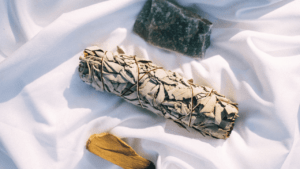What are Negative effects of smudging?
Ghost smudging a practice that originated in Africa comes with its negative effects on health. This practice involves placing sacred herbs under the legs of people as they sleep and then burning them in order to have a better night’s rest. Ghost smudging has also been quite popular with some members of the Native American community as well. Ghost smudge sticks are made with sacred plants, and they can contain many different substances. Some people believe that these substances can promote good luck and increase a person’s energy while others believe they may have harmful side effects.
Ghost smudging is also believed to be a traditional Hindu ceremony where people place black soot on their hair and face. This practice thought to ward off evil spirits is popular in some parts of India, Pakistan, and Nepal. However, it has been banned in certain regions because of the negative effects of smudging on human health.
Myths of Ghost Smudging
There are many myths surrounding ghost smudging. Some people claim that it can cure cancer or other diseases. Others say that it brings good luck or protection from harmful spirits. Ghost smudging is also commonly associated with witchcraft and black magic. But does this actually have any scientific evidence? The answer is no.
Ghost smudging is a practice that has been used in Native American culture for centuries. It’s not a new thing, but it has recently gained attention and popularity among white people who want to learn about the tradition.
Ghost smudging is a religious ceremony that involves burning sage, sweet grass, or other herbs while chanting and praying to the spirits of the ancestors. This practice has been linked to physical and mental health benefits as well as spiritual growth.
Negative Effects Of Ghost Smudging
01. Burning sage can be dangerous.

The burning of sage leaves releases a toxin called thujone into the air. Thujone can cause serious health problems such as headaches and dizziness. If you are unfamiliar with how to properly burn sage, you may think that it is harmless. But, this could be very dangerous to your health and potentially fatal if done incorrectly.
While burning sage is a popular ritual, it can also be dangerous.
- Burning sage can cause a fire to spread to nearby plants, trees, and buildings.
- Burning sage is an extremely dry plant that can cause its own smoke to ignite fires in buildings or vehicles.
- The smoke from burning sage leaves contains toxic chemicals that can cause serious health problems for people with respiratory ailments such as asthma and chronic obstructive pulmonary disease (COPD).
02. The energy around ghost smudging is not uplifting or healing.
The energy around ghost smudging is not uplifting or healing. It’s more like a dark, depressing feeling.
Ghost smudging is a practice that originated in Native American culture, and it is used by many people today to help them deal with stress and anxiety. The purpose of the ritual is to send positive energy into the world so that you can feel better physically and emotionally. But some people have been left feeling worse than before they started the ritual because of all the negative energy floating around.
This can be normal — but it doesn’t have to be! Ghost smudging is also a great way to help you heal from any negative experiences you’ve had in life.
The reason why some people get so stressed out during a ghost-smudging ceremony is because of all the negative energy surrounding them at the time of their ceremony — there are lots of negative emotions floating around, including sadness, anger, and fear.
03. Ghost smudging is not a long-term solution and only works as long as the sage smoke fills the space.
Ghost smudging is the act of burning herbs, flowers, or other natural products in order to remove or banish negative energies from a room or space.
The practice of ghost smudging has been around for thousands of years, with different cultures and Indigenous populations around the world using it to purify homes, eliminate negative energy and protect against illness. But this sense of satisfaction and fullness lasts as long as the smoke during smudging in the room.
You also have to consider the length of time that you’ve been doing this type of ceremony. If it’s been several years since your last cleansing ceremony, then it’s likely that your energy has become tainted and will attract even more negative energy if you continue using the same type of ceremony.
04. Using ghost smudging to harm others (or yourself) becomes a self-fulfilling prophecy.
Ghost smudging is a cleansing ceremony used by many Native American tribes to ward off evil spirits and harm others (or yourself). The practice dates back thousands of years, and it’s still going strong today. Many people use Ghost Smudging for personal protection and to help themselves. However, there are health risks associated with ghost smudging that you need to know about.
The first thing to consider is that using ghost smudging to harm others (or yourself) becomes a self-fulfilling prophecy. If you don’t cleanse yourself properly, you’re actually encouraging negative energies to come after you because they can sense your negative energy.
If you want to do a cleansing ceremony, use sage instead of tobacco — sage burns at a lower temperature than tobacco does and won’t leave soot residue like tobacco leaves would do when burned in an incense burner during a Ghost Smudging ceremony. Even if you use sage it might still pose health risks.
05 Ghost smudging your home can affect pets and children.
Ghost smudging your home can be harmful to pets and children. A study conducted by the National Center for Biotechnology Information found that exposure to smoke from burning sage leaves caused respiratory infections in both mice and rats. The study also revealed that smoke can cause damage to the lungs, especially in young animals.
According to an article published by the Centers for Disease Control and Prevention (CDC), pet owners should avoid using ghost smudging as a way to keep their pets healthy. In addition, children should also avoid using this method because it can cause respiratory problems in some cases.
When people use ghost smudging, they are burning herbs that contain toxins like lead and mercury. These toxins are released into the air and inhaled by people who live or visit the home where ghost smudging occurs. The CDC reported that children under the age of 5 are most likely to be affected by these toxins when they come into contact with them through inhalation or ingestion of contaminated food or water (CDC).
Takeaway: Take care considering the negative effects of smudging
The practice of smudging is an ancient practice that is used to purify spaces and remove negative energy from them. The most common form of Ghost Smudging involves burning herbs on fire, but there are other ways to do it as well. For example, some people use natural oils or powders to cleanse their homes, while others will burn tobacco leaves or dried herbs as part of their cleansing process.
While many people believe that Ghost Smudging is harmless and even beneficial for their health and well-being, there are some risks involved with this practice.
For example, it has been shown that some people who have experienced Ghost Smudging have reported being overwhelmed by the smell of smoke and burned herbs in their homes for days after the ritual was completed; this has led some people to believe that Ghost Smudging may not be safe for everyone who practices it.
Ghost smudging is a common practice in many cultures, but it can be risky if you don’t know what you’re doing. Here’s what you need to know about the health risks of ghost smudging. Today, ghost smudging is still practiced by many Native American tribes across North America. It can also be found in places like New Zealand, where Maori people use it for similar reasons.
Are you sure you want to do this despite knowing the negative effects of smudging?
First, remember that ghost smudging is a very old practice, and it’s not always safe. It can cause illness or even death from the smoke released during the process. If you’re trying to contact your loved ones who have passed away, there are other ways that might be more effective than smoking tobacco and burning leaves.
Some people believe that ghost smudging helps them find lost objects or money that has been misplaced by accident or misfortune. Others think it will protect them from bad spirits or negative energy in general. Either way, if you’re thinking about trying ghost smudging as an alternative to traditional remedies such as acupuncture or herbal healing (for example), talk with your doctor first!
Safety Tips to avoid negative effects of smudging
Smudging isn’t a harmful practice if done carefully. However, traditional smoke from burning materials is unhealthy, so use purified or scented versions of them if you can. Even better—just use the actual herbs and skip the burning altogether. You could get even healthier smudging by placing the herbs in a bowl and using a humidifier to disperse their scent through your house. Either way, this practice is relatively safe for you and your family as long as you do it properly. Following these safety tips, one can easily avoid the negative effects of smudging. You can also find guidelines on how to ghost smudge here.
Conclusion
With the rising popularity of ghost hunting and reality shows, there has also been a boom in self-proclaimed ghost hunters coming into existence. This gave rise to the concept of “smudging” which is a kind of cleansing using smoke from burning herbs (usually White Sage). Unfortunately, many people are unknowingly exposed to the health risks that are associated with ghost smudging. Take note that the health risks we will be addressing in this article pertain only to ghost smudging, and not other practices that involve candles or incense during spiritual cleansing sessions.







